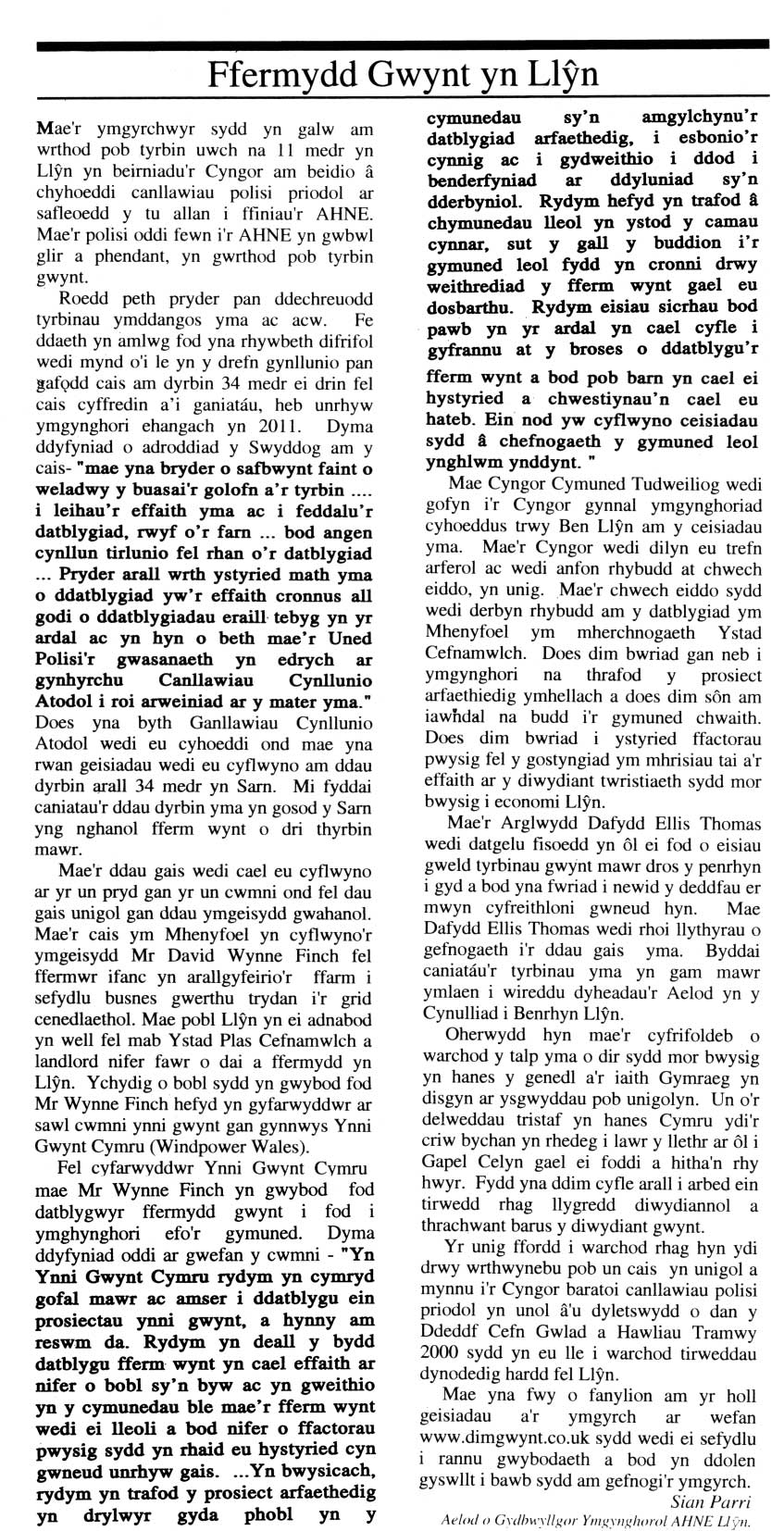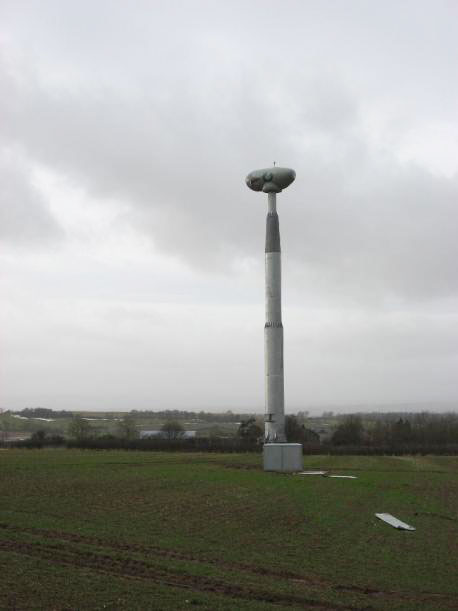Llanw Gorffennaf 2013
27-6-2013 Cambrian News
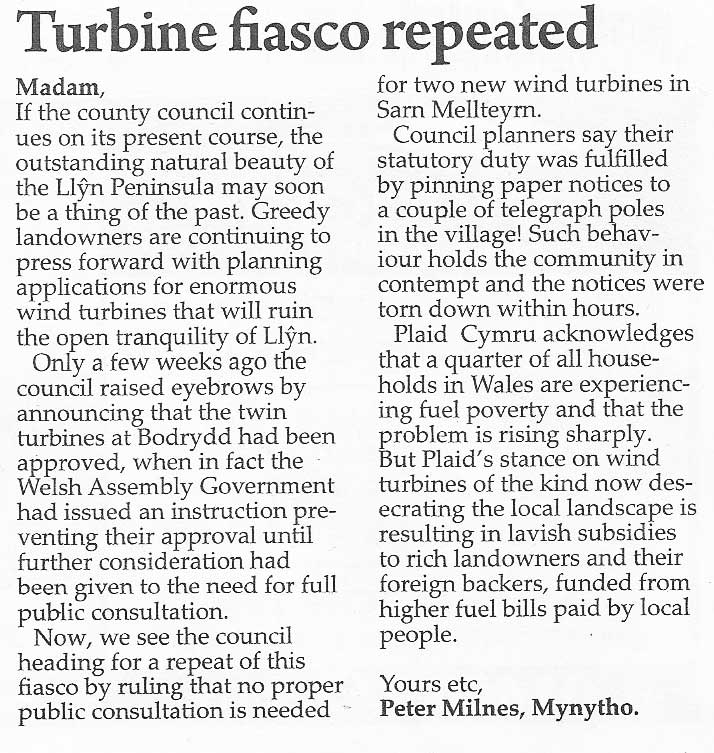
12-6-2013 DimGwynt
Bydd ceisiadau newydd am ddau dyrbin comersial mawr arall yn Sarn Mellteyrn yn troi’r pentre yn fferm wynt – Mr David Wynne Finch, Ystad Cefn Amwlch- (C13/0338/32/LL) – Penyfoel Sarn, a (C13/0337/32/LL) – Trygarn Sarn.
Mewn datganiad i’r gymuned y mae disgrifiad o Mr David Wynne Finch fel ffermwr ifanc, yn ffermio Penyfoel sydd angen y dablygiad er mwyn sicrhau hyfywedd masnachol y fferm. Mae’r datganiad yn nodi y bydd yn arallgyfeirio’r fferm i gynhyrchu trydan.
Nid yw’r datganiad yn cydnabod fod Mr Wynne Finch hefyd yn gyfarwyddwr ar – Windpower (Wales) Limited, Windpower (Wales) group PLC, Windpower (Hiraethog) Limited a Lima energy limited, a fod ei gyfaill David Cameron yn dwad i Gefnamwlch ar ei wyliau.
Two new applications will turn Sarn Mellteyrn on the Llyn peninsula into a defacto wind farm – Mr David Wynne Finch – (C13/0338/32/LL) – Penyfoel Sarn, and (C13/0337/32/LL) – Trygarn Sarn.
In the community statement on the first proposal it states – He is a young farmer , farming Penyfoel…. the scheme is designed to ensure the farms commercial viability……
Mr Wynne Finch also happens to be a director of – Windpower (Wales) Limited, Windpower (Wales) group PLC, Windpower (Hiraethog) Limited and Lima energy limited.
Cynghorau Cymuned yn galw am ymgynghori ehangach a ‘EIA’ 12-6-2013

4-6-2013 Cambrian News
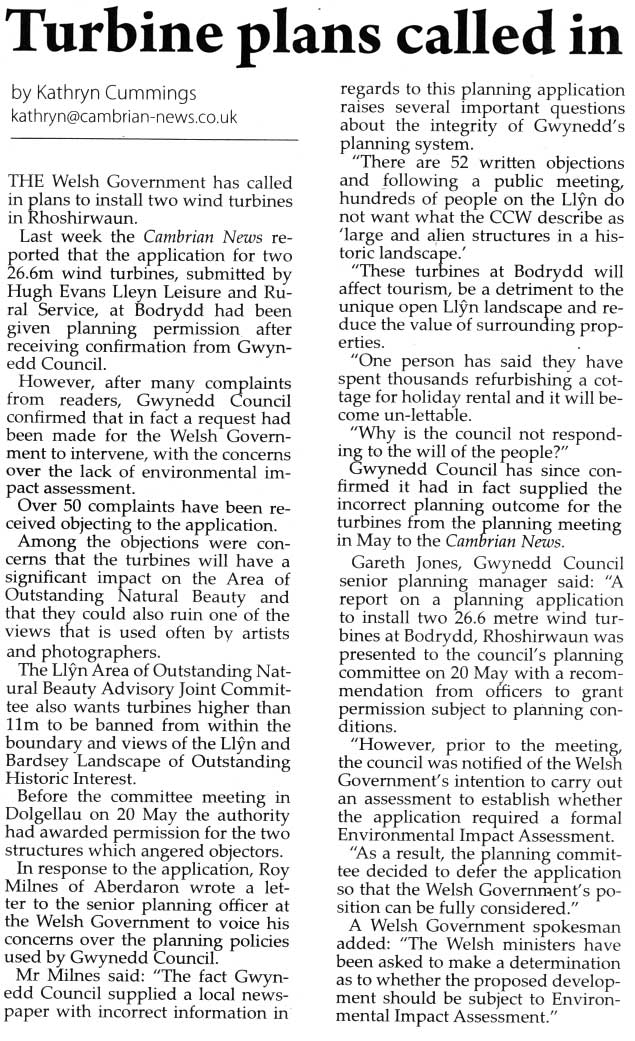
6-6-2013 C&D herald
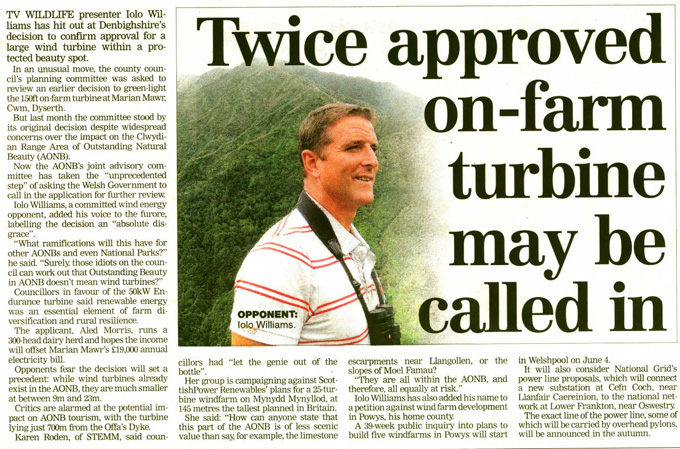
Blades snap off the same windturbine as is proposed at Bodrydd earlier this year. Bodrydd proposal is for two of these!
Read the story in the Northern Echo
Caernarfon & Denbigh Herald 25-4-2013
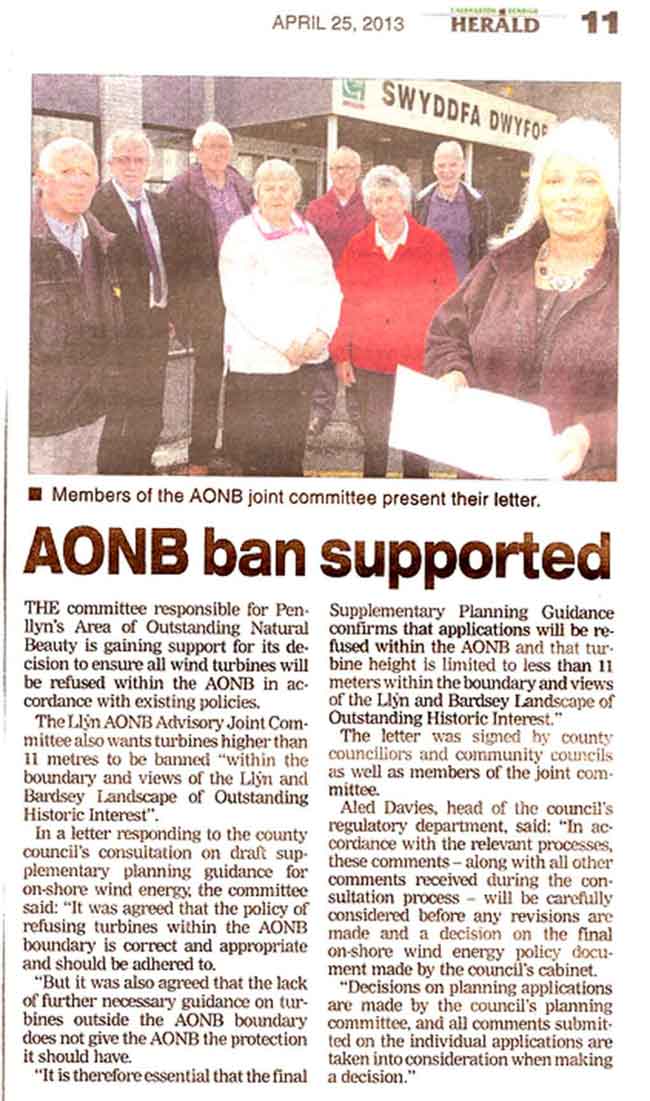
Golwg 25-10-12
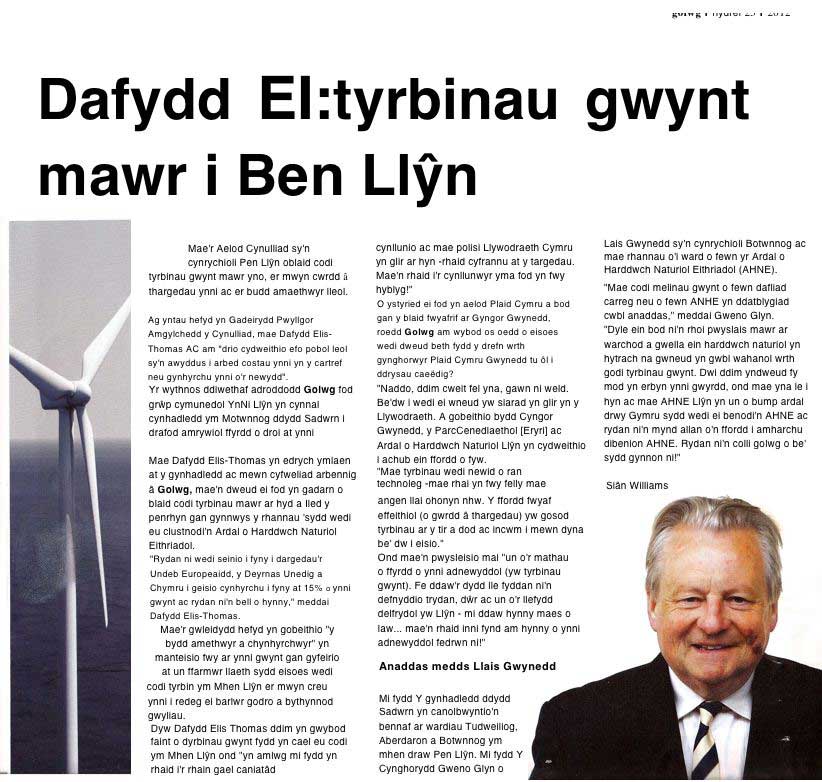
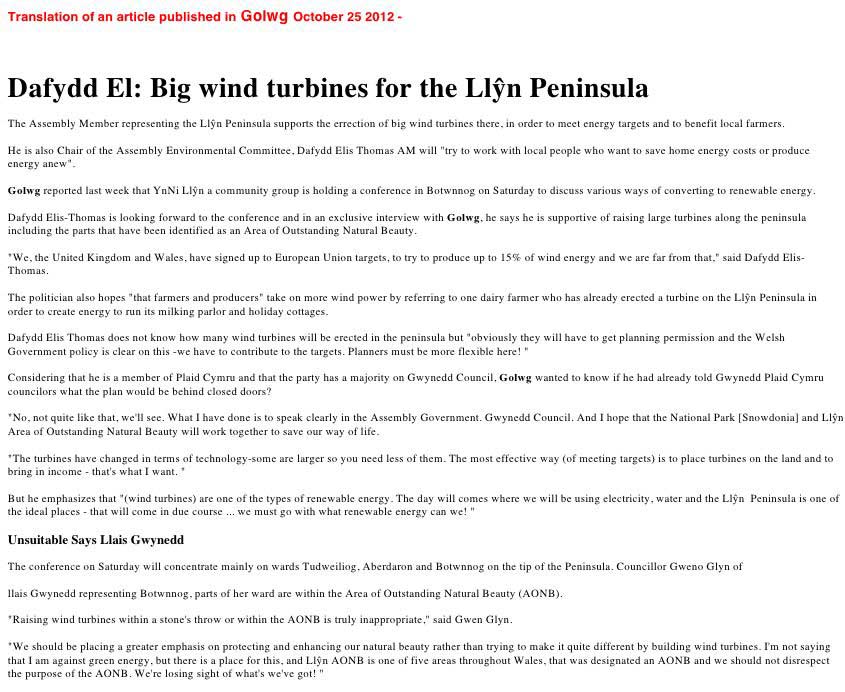
Golwg 18-10-12
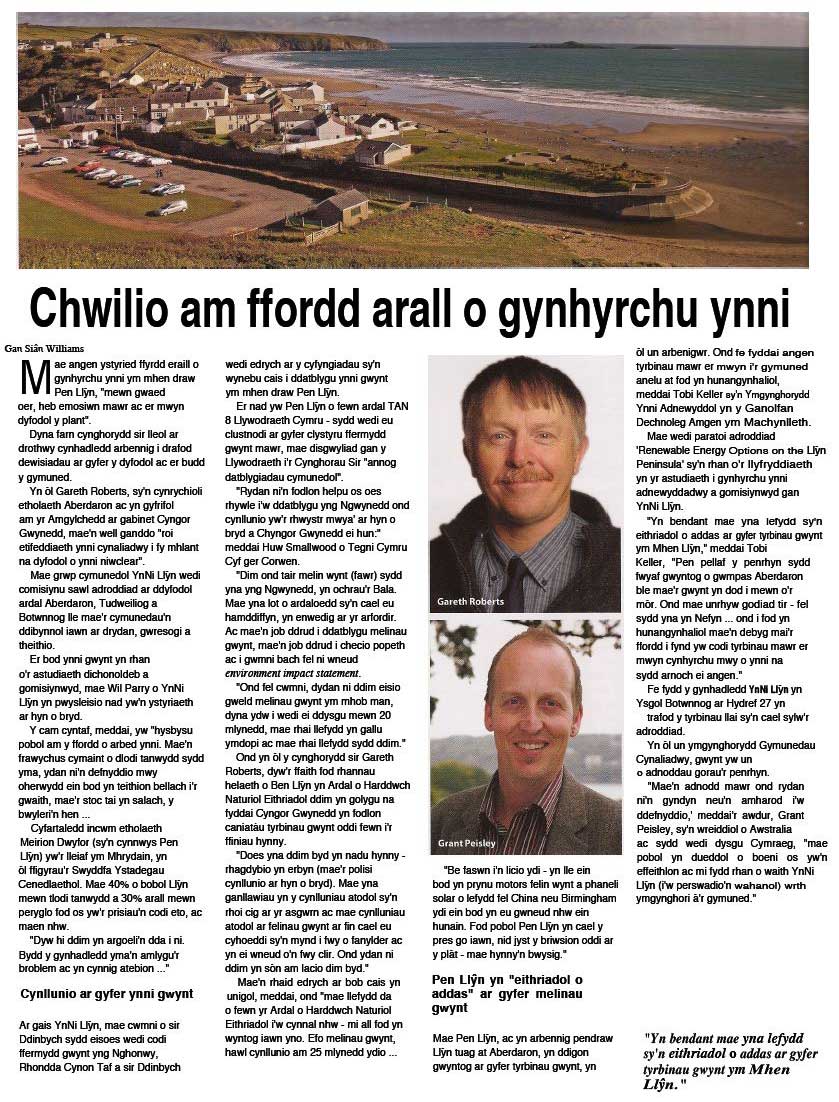
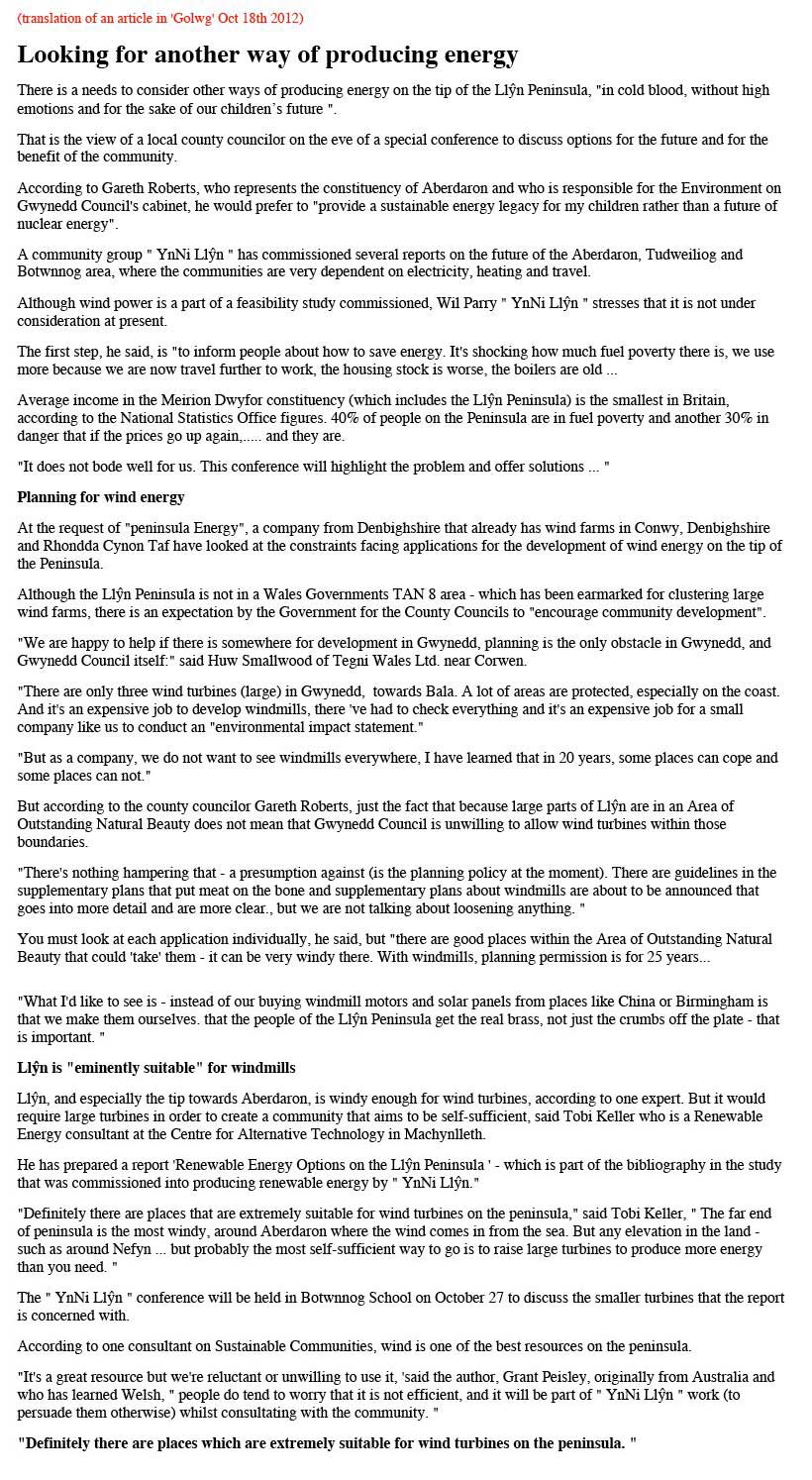
High Court find in favour of the Landscape over wind
High Court judge Mrs Justice Lang has rejected Sea & Land Power & Energy Ltd’s plans for four giant turbines near Hemsby, Great Yarmouth on the grounds that “national renewable energy targets do not negate the local landscape policies” [1]. http://bit.ly/Le1v4j
Commenting on this decision, Tom Leveridge, Senior Energy Campaigner for the Campaign to Protect Rural England, says:
“The countryside should play a role in tackling climate change, but we need to find a better balance between cutting carbon and protecting important landscapes. This application was another example of giant turbines being proposed in an inappropriate location. Mrs. Justice Lang’s decision will reassure other local communities keen to protect valued landscapes but who feel like their concerns are increasingly being ignored as a result of Government energy policy.
“Local communities need to be empowered to decide for themselves how they want to contribute to tackling climate change including by identifying those areas where onshore wind is, and isn’t, appropriate.”
End
Notes to Editors
[1] Neutral Citation Number: [2012] EWHC 1419 (Admin), Case No: CO/13120/2010, http://www.bailii.org/ew/cases/EWHC/Admin/2012/1419.html
Wind farm subsidies to top £1bn this year
The cost of subsidies for wind farms is expected to top a billion pounds this year for the first time.
The disclosure comes ahead of a long-awaited government announcement to cut the size of the subsidy, which benefits the big energy companies but is added on to household electricity bills.
The scale of the reduction was last night bogged down in Whitehall wrangling. Edward Davey, the Energy and Climate Change Secretary, was expected to make a decision before the Commons breaks up for the summer on Tuesday.
However, Whitehall sources told The Sunday Telegraph last night that discussions were “still continuing” – code for Coalition rows about the scope of subsidy cuts – leading to fears that the announcement could be postponed.
Original government plans were to cut onshore wind subsidies by 10 per cent for the period 2013-17, a move backed by the Liberal Democrats. Conservative MPs have been fighting for cuts of about 25 per cent.
The consumer subsidies were introduced by the Labour government to encourage green energy projects, including wind farms. However, it is now generally accepted that the subsidies are too generous as technologies have become cheaper.
According to an analysis of official figures by the think-tank Renewable Energy Foundation (REF), the total annual subsidy for onshore and offshore wind farms has, for the first time, topped £1billion. REF estimates that on current renewable energy targets – and with only modest cuts – the energy companies will have received £100 billion in subsidies by 2030.
REF said it expects 10 companies, between them, to pocket £800million through subsidies over the next 12 months.
The biggest winner is Dong Energy, a Danish energy company, which is on course to earn more than £156 million in subsidies through its British wind farms. Dong is also paid for the energy that it sells to the National Grid.
The next highest earner is Vattenfall, a state-owned Swedish energy conglomerate, which will earn £128 million from its wind farms. Out of the top 10, only two of the companies are British-owned – Centrica, which will receive £58 million in subsidy and SSE, which is due £53 million.
The remaining energy companies that make money out of British wind farms and British consumers are based in Germany, Norway, Spain and Italy.
The subsidy cut has caused anxiety in the onshore wind farm business, which has lobbied hard to keep the reduction at 10 per cent – a figure that was first mooted in a consultation document last year. The reduction was suggested as a means of deterring “poorly sited projects which are more expensive to develop”. Offshore wind farms, which are more expensive and receive a bigger subsidy, face a 5 per cent subsidy cut.
Back-bench Conservative MPs want a bigger reduction. Oliver Letwin, a Cabinet minister who is close to David Cameron, revealed in an email last month that he expected the subsidy to be scrapped by 2020.
REF, which opposes wind farms on the grounds of cost and on the damage they do to the countryside, said that the planned subsidy cut – even at a 25 per cent reduction – may still not be enough to cap costs because of the number of planned wind farms.
John Constable, director of REF, said: “The total savings that a 25 per cent reduction in subsidy could produce are macro-economically significant, and it is unlikely that either the Treasury or the Department for Business, Innovation and Skills will want to stop there. Retrospective cuts for existing wind farms and those in construction cannot be ruled out.”
He described the future saving as “a big barnacle scraped off the hull of the UK economy”.
The size of the cut, and a possible delay in the announcement, has caused uncertainty in the wind energy industry. The industry’s figures show that 348 onshore wind farms are in operation and that 275 have planning consent but remain unbuilt. REF claims that “investor anxiety over the long term sustainability of the subsidies is a major factor” in explaining why energy companies have not constructed more onshore wind farms.
One developer, RES, which has not started construction on several projects that have planning permission, insisted that it was nothing to do with the subsidy cut.
A spokesman for RES said: “There is nothing on any of these wind farms that is holding them up. They are just going through due process.”
Þ Proposals for an offshore wind farm in the Irish Sea between Anglesey and the Isle of Man have been submitted.
The joint venture between Centrica and Dong Energy could include up to 440 turbines. Centrica said that the plans were in an extremely early stage.

